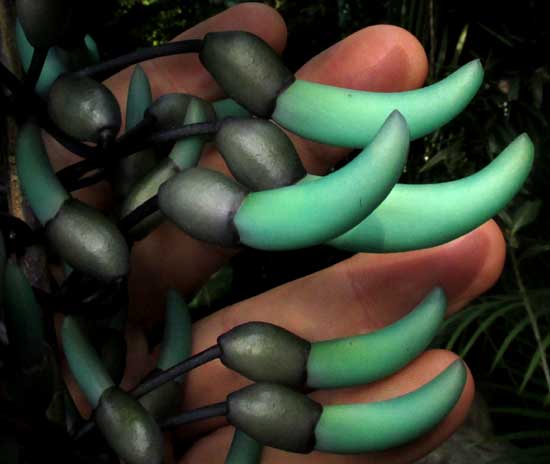Excerpts from Jim Conrad's
Naturalist Newsletter
from the October 29, 2017 Newsletter, a special on-the-road edition with notes taken in mid October near Tepotzlán, Morelos state, MÉXICO
Elevation about 5315 ft (1620m), at 18°59′07″N 99°05′59″W
JADE VINE
My friend took me to see his Jade Vines, for these were flowering at their peak of perfection, and of all his plants I think he was proudest of them. You can see why below:

You don't often see flowers colored like that. The dangling flowering heads averaged around 15 inches long (40cm), but I read that such racemes can reach ten feet long (3m). The vine's leaves are compound, consisting of three leaflets.
Jade Vines are STRONGYLODON MACROBOTRYS, members of the Bean Family, the Fabaceae. A closeup showing the flowers' shape and size relative to my fingers is shown below:

At first it's hard to recognize the Bean Family's typical butterfly-shaped or "papilionaceous" flowers. The trick is in knowing that the blackish cups at the flowers' bases are leathery calyxes with very low sepals, and the curving, turquoise items are the corolla's two top petals fused along their common margin, forming the typical papilionaceous "banner" or "standard." These banner also are somewhat leathery, and wrap around the other flower parts, protecting them until the blossoms are more mature.
Jade Vines are native to rainforests of the Philippines' Luzon, Mindoro and Catanduanes Islands, where they are seriously endangered by mass deforestation. In the wild they are pollinated by bats, so one visualizes a leathery banner enshrouding a flower's other parts until a certain night when sexual maturity is reached, at which point it peels back, exposing the more fragile, sexual parts. Beneath my friend's vines we found such opened blossoms, possibly knocked there by bats the previous night. One such flower is shown below:

There you see the turquoise banner curled back toward the left, while the purplish "keel" at the bottom, flanked by short, rounded "wings," further conceal the sexual parts. With the keel and wings removed, you can see the stamens below:

Notice that these stamens are "diadelphous," which means that filaments of nine stamens unite at their bases to form a cylinder around the ovary's slender, stigma-tipped style, with the tenth stamen held apart, curled backward like the banner. Many papilionaceous Bean Family flowers don't have their tenth stamen held separately, in which case the stamens are said to be "monadelphous."